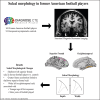Sulcal morphology in former American football players
- PMID: 41048544
- PMCID: PMC12492488
- DOI: 10.1093/braincomms/fcaf345
Sulcal morphology in former American football players
Abstract
Repetitive head impacts are associated with structural brain changes and an increased risk for chronic traumatic encephalopathy, a progressive neurodegenerative disease that can only be diagnosed after death. Chronic traumatic encephalopathy is defined by the abnormal accumulation of phosphorylated tau protein, particularly at the depths of the superior frontal sulci, suggesting that sulcal morphology may serve as a relevant structural biomarker. Contact sport athletes, such as former football players, are at elevated risk due to their prolonged exposure to repetitive head impacts. Cortical atrophy linked to underlying tau accumulation may result in shallower and wider sulci, potentially making sulcal morphology an imaging marker for identifying individuals at risk for this disease. This study investigated sulcal morphological differences in former football players and examined associations with age, football-related exposure, clinical diagnosis of traumatic encephalopathy syndrome, levels of certainty for chronic traumatic encephalopathy pathology, neuropsychological performance, and positron emission tomography imaging using flortaucipir. We analysed structural magnetic resonance imaging data from 169 male former football players (mean age 57.2 (8.2) years, range 45-74) and 54 age-matched, unexposed asymptomatic male controls (mean age 59.4 (8.5) years, range 45-74). Sulcal depth and width were quantified using the CalcSulc, focusing on two regions in each hemisphere commonly affected by chronic traumatic encephalopathy pathology: the superior frontal and occipitotemporal sulci. Generalized least squares models were used to assess group differences and interactions with age and football exposure variables, including age of first exposure, total years played, and cumulative head impact exposure. An analysis of covariance evaluated relationships between sulcal morphology, clinical measures, and flortaucipir uptake, adjusting for age, race, body mass index, education, imaging site, apolipoprotein E4 status, and total intracranial volume. Former football players demonstrated significantly shallower sulcal depth in the left superior frontal sulcus compared to unexposed controls. Earlier age of first exposure and longer football careers were associated with greater widening of the left occipitotemporal sulcus. Higher cumulative head impact exposure was linked to reduced sulcal depth in the left superior frontal region. However, sulcal morphology was not associated with clinical diagnosis, levels of certainty, neuropsychological test performance, or flortaucipir imaging. These findings suggest that sulcal morphology may reflect cumulative exposure to repetitive head impacts, particularly in brain regions vulnerable to chronic traumatic encephalopathy pathology. Future ante- and post-mortem validation studies are needed to determine whether sulcal morphology can serve as a reliable in vivo biomarker of risk.
Keywords: former American football players; neuroimaging; repetitive head impact; sports-related head injury; structural MRI.
© The Author(s) 2025. Published by Oxford University Press on behalf of the Guarantors of Brain.
Conflict of interest statement
Dr. Laura Balcer is the Editor-in-Chief of the Journal of Neuro-Ophthalmology. Dr. Charles Bernick receives research support from the Ultimate Fighting Championship, Top Rank promotions, and Haymon Boxing. Dr. Alexander P. Lin has an ownership interest as a Co-founder of BrainSpec and consults for Agios Pharmaceuticals, Biomarin Pharmaceuticals, DesignTx, and Moncon MRI. Dr. Jeffrey L. Cummings has provided consultation to Acadia, Actinogen, Acumen, AlphaCognition, Aprinoia, AriBio, Artery, Biogen, BioVie, Bristol-Myers Squib, Cassava, Cerecin, Diadem, EIP Pharma, Eisai, GemVax, Genentech, GAP Innovations, Janssen, Jocasta, Karuna, Lighthouse, Lilly, Lundbeck, LSP/EQT, Merck, NervGen, Novo Nordisk, Oligomerix, Optoceutics, Ono, Otsuka, PRODEO, Prothena, ReMYND, Roche, Sage Therapeutics, Signant Health, Simcere, Suven, SynapseBio, TrueBinding, Vaxxinity, and Wren pharmaceutical, assessment, and investment companies. He owns the copyright of the Neuropsychiatric Inventory. Dr. Eric M. Reiman is a compensated scientific advisor for Alkahest, Alzheon, Aural Analytics, Denali, Green Valley, Retromer Therapeutics, and Vaxxinity, and a co-founder of ALZPath. Dr. Robert A. Stern is a member of the Board of Directors of King-Devick Technologies, Inc. (Chicago, IL, USA), and he receives royalties for published neuropsychological tests from Psychological Assessment Resources, Inc. (Lutz, FL, USA). IKK receives funding for a collaborative project from Abbott Inc. She receives royalties for book chapters. Her spouse is an employee at Siemens AG and a stockholder of Siemens AG and Siemens Healthineers.
Figures


References
LinkOut - more resources
Full Text Sources
